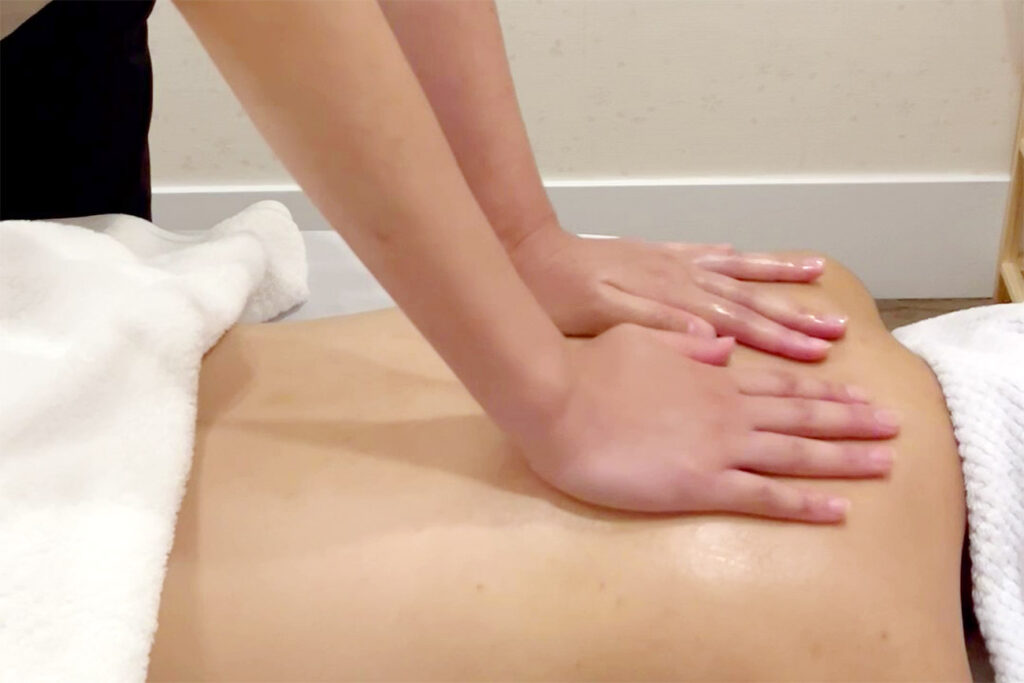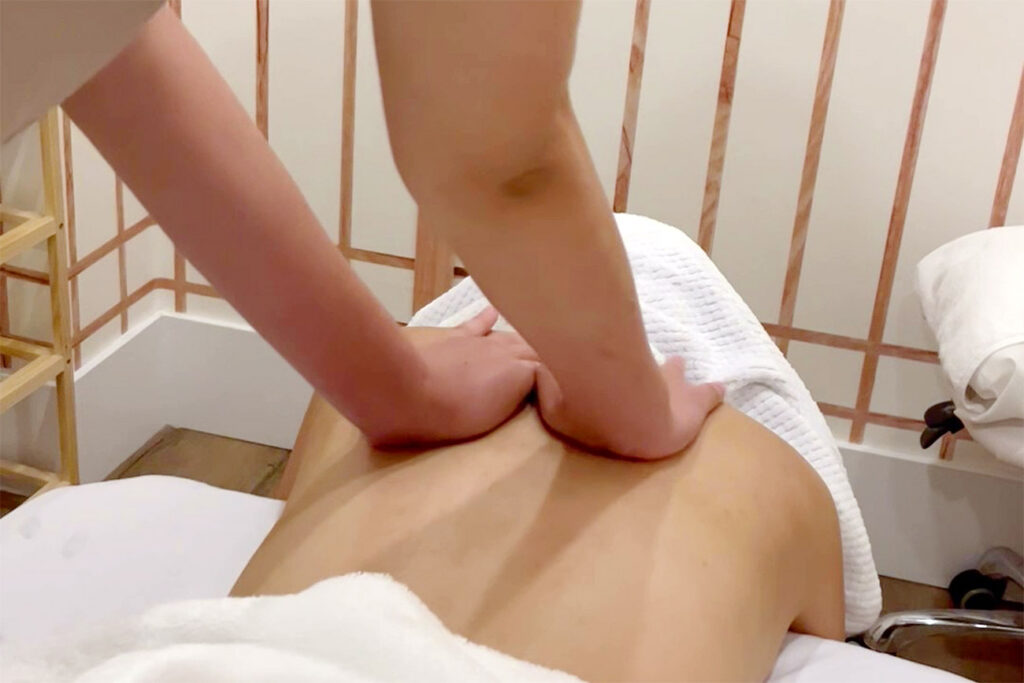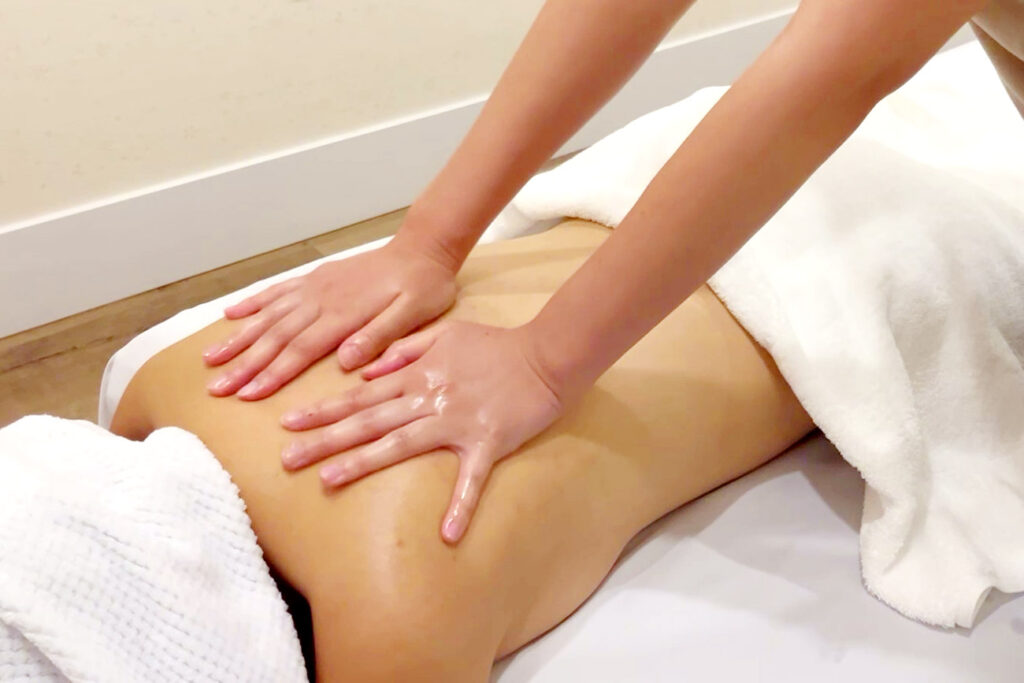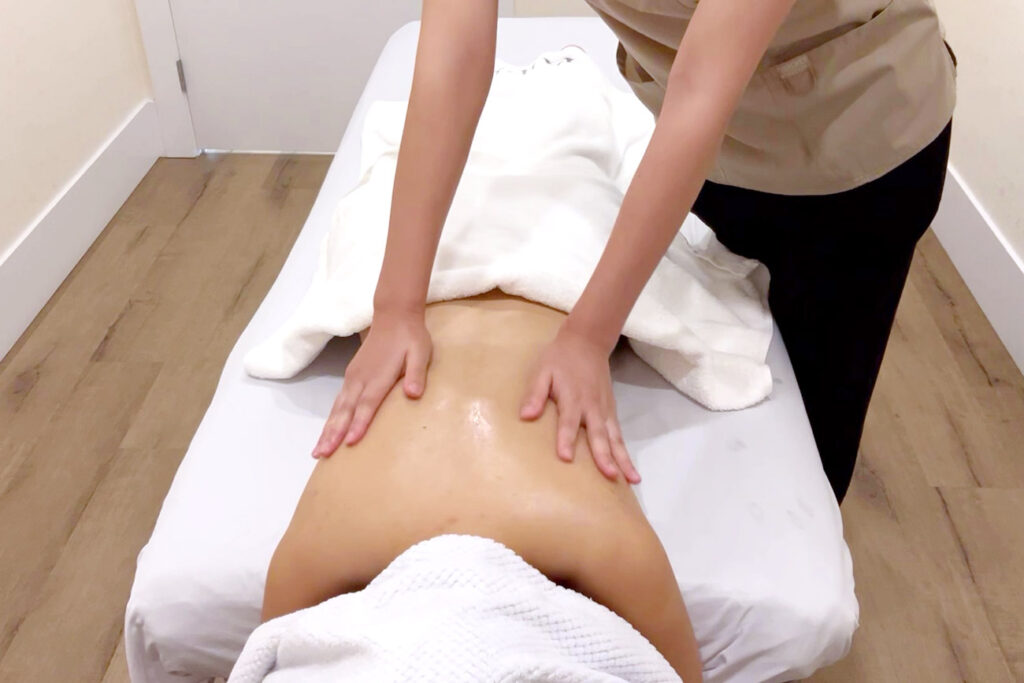Effleurage is commonly used in aromatherapy massage. In this article, we’ll explain effleurage in depth—from its fundamentals and expected benefits to specific techniques.
Deepen your knowledge to ease daily fatigue and achieve deeper relaxation.
- [Tsubaki Massage Technique 1] What Is Petrissage?
- [Tsubaki Massage Technique 2] What Is Kneading?
- [Tsubaki Massage Technique 3] What Is Effleurage?
- [Tsubaki Massage Technique 4] What Is Friction?
- [Tsubaki Massage Technique 5] What Is Holding?
What Is Effleurage? Basics and Appeal
Definition and Etymology of Effleurage
Effleurage is a massage technique for relaxation and therapeutic purposes that comes from the French word “effleurer” (“to stroke, to touch lightly”). It features gentle, rhythmic gliding over the skin using the whole palm and the pads of the fingers. Long cherished throughout Europe as a way to ease tension in body and mind, effleurage is more than superficial stimulation: it influences the nervous system to encourage deep relaxation. It can also promote blood and lymphatic flow and support the removal of waste products. In aromatherapy treatments, it plays an important role as an introductory technique when applying aromatic oils to the skin.
Some trace its origins back to ancient Greece and Rome, where oil massage was widely practiced to soothe the body and maintain health. As massage spread across Europe and various methods developed, effleurage became established as one such technique. Today it is used in spas, esthetic salons, and clinical settings. Thanks to its effectiveness and safety, it is trusted by many people.
Main Purposes and Effects of Effleurage
The primary goals of effleurage are relaxation, promotion of blood and lymph circulation, and relief of muscular tension. These contribute to stress reduction, recovery from fatigue, and improved immune function.
Through touch, effleurage gently stimulates the nervous system and shifts the body toward parasympathetic dominance, encouraging relaxation. This can ease anxiety and tension and create a sense of comfort. Gentle stroking helps dilate blood vessels and improve circulation, enhancing oxygen delivery to cells and stimulating metabolism. By promoting lymphatic flow, it also supports the removal of waste and excess fluid, helping reduce swelling.
Effleurage warms the muscles and increases their pliability, which expands joint range of motion and makes movement smoother. By easing muscular tension, it can also help relieve shoulder and lower-back discomfort. Combining effleurage with other massage techniques can further enhance results—for example, warming tissues with effleurage before kneading or compression allows for more effective work on deeper muscles.
How Effleurage Differs from Other Techniques
Compared with other massage methods, effleurage is characterized by a gentler, softer touch.
- Kneading: Grasping and working the muscles to reach deeper layers. Because the stimulation is stronger, it is used to relieve tension and reduce pain.
- Tapping: Rhythmic percussive movements intended to stimulate the nervous system and promote circulation; it emphasizes activation rather than relaxation.
- Compression: Applying focused pressure with the fingers or palms to specific areas to relieve tension, reduce pain, or address trigger points; its effects are more localized than effleurage.
In this way, effleurage excels at gently covering wide areas to encourage relaxation. In aromatherapy, it serves as an introduction when applying oils and, when used between other techniques, helps deepen the overall relaxation effect.
Three Key Benefits of Effleurage

Deep Relaxation and a Sense of Comfort
One of the most noticeable effects of effleurage is the deep relaxation and comfort it provides. Gentle touch stimulates cutaneous receptors, and the resulting signals to the brain increase parasympathetic activity. As this state prevails, heart rate and respiration decrease, muscle tension eases, and the body relaxes.
Effleurage also offers psychological benefits. Warm, caring touch fosters reassurance and trust and can reduce feelings of loneliness. For those experiencing stress or anxiety, it helps release mental and physical tension and restores a calm state. In aromatherapy treatments, the scents of oils such as lavender or chamomile can amplify relaxation.
Effleurage is not just a technique; it is a holistic approach that restores balance and enhances well-being.
Effective Promotion of Blood and Lymph Circulation
Effleurage excels at promoting blood and lymph flow. Gentle stroking helps dilate vessels and increase circulation, improving the delivery of oxygen and nutrients while facilitating the removal of waste products.
It also promotes lymphatic movement. Because the lymphatic system supports immunity and waste clearance, stagnation may lead to swelling, fatigue, or reduced resistance. By gliding gently along lymph pathways—especially from the extremities toward the heart in the arms and legs—effleurage smooths lymph flow and helps with waste removal.
Warming and Softening Muscles: Preparation for Other Techniques
Effleurage warms and softens muscles, making it ideal as a preparatory step before deeper techniques. Warm tissues are more flexible, joints move through a greater range, and subsequent methods—such as kneading or compression—can more effectively reach deeper layers.
By easing tension, effleurage also improves circulation, enhances oxygen delivery, and supports the removal of fatigue-related by-products.
Specific Effleurage Techniques

Basic Stroke: Gentle Gliding with the Whole Palm
The foundation of effleurage is gently gliding over the skin with the whole palm, not just the fingertips. Keeping the palm in full contact distributes pressure over a wider area for a pleasant, soothing feel. Adjust the pressure to the client’s condition and goals—use lighter pressure for deeper relaxation and slightly firmer pressure to emphasize circulation.
Stroke direction generally runs from the body’s center toward the extremities—for example, from the shoulder toward the wrist on the arms, or from the thigh toward the ankle on the legs. To emphasize lymphatic drainage, strokes may be reversed from the extremities toward the center. Move slowly at a steady pace, coordinating with breathing to deepen relaxation.
Delicate Fingertip Touch: Applications for the Face and Neck
Because the face and neck are thin and sensitive, effleurage here requires a more delicate touch. Use the fingertips rather than the full palm and glide very gently. Around the eyes and mouth—where the skin is especially thin—use the pads of the fingers with almost imperceptible pressure.
Work outward from the center of the face: on the forehead, from the glabella toward the temples; on the cheeks, from the nose toward the ears; on the neck, from the collarbone toward the jawline. These strokes can also encourage lymphatic flow. Fingertip effleurage helps with facial puffiness and dullness and can ease neck stiffness while enhancing relaxation and, in some cases, sleep quality.
Circular Motions: An Effective Approach for the Shoulders and Lower Back
For areas prone to stiffness—such as the shoulders and lower back—incorporating circular motions is effective. Using the palm or fingertips, glide in slow circles along the muscles, adjusting the circle size to the muscle area. Around the shoulders, focus on the scapular region; around the lower back, follow the erector spinae. Adjust pressure to the client’s condition: use slightly firmer pressure for pronounced stiffness and lighter pressure to emphasize relaxation.
Circular movements warm the tissues, increase flexibility, promote circulation, and support waste removal—helpful for relieving shoulder or lower-back discomfort and fatigue.
Risks and Precautions of Effleurage

Contraindications: When to Avoid Effleurage
Effleurage is generally safe, but it should be avoided in the following situations:
- Fever: Because effleurage can promote circulation, it may further raise body temperature.
- Infections: It may worsen symptoms or increase risk of spread.
- Skin conditions: Inflammation or eczema may be aggravated by stimulation.
- Thrombosis: Absolutely avoid due to the risk of dislodging a clot.
- Malignancy: Avoid, as stimulation could potentially influence disease progression.
- Early pregnancy: Avoid due to bodily instability in early gestation and potential risks.
- Other cases: Follow medical guidance if a doctor has advised against massage.
Even outside these cases, if you feel unwell or unsure, it’s best to postpone massage until you are in better condition.
Aftercare: Hydration and Rest
After effleurage, be sure to hydrate and rest. As circulation increases, waste products are more readily cleared; proper fluid intake supports this process and aids recovery from fatigue.
Because effleurage is deeply relaxing, drowsiness may occur. Rather than pushing yourself, rest to help the body recover. Avoid stimulants such as caffeine and alcohol; choose warm drinks or a light snack. Wait about an hour before bathing. Prolonged soaking in hot water can cause abrupt changes in blood pressure and may lead to discomfort.
Summary: Restore Balance with Effleurage

Effleurage is a gentle technique that soothes body and mind, offering relaxation, improved circulation, and relief of muscular tension. Its basic method uses full-palm, gentle gliding, with variations such as delicate fingertip work and circular motions. Effleurage is effective on its own and even more so when combined with other massage techniques.
To release everyday stress and fatigue and refresh body and mind, experience effleurage with Tsubaki’s massage.
